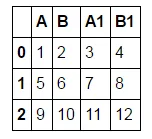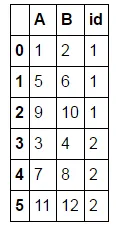4个回答
11
pd.wide_to_long 函数几乎是为这种情况量身定制的,其中你有许多相同的变量前缀,以不同的数字后缀结尾。唯一的不同之处在于,您的第一组变量没有后缀,因此您需要先重命名列。
pd.wide_to_long 的唯一问题是它必须具有识别变量 i,而不像 melt。使用 reset_index 创建一个独特的标识列,稍后将其删除。我认为这可能会在未来得到纠正。
df1 = df.rename(columns={'A':'A1', 'B':'B1', 'A1':'A2', 'B1':'B2'}).reset_index()
pd.wide_to_long(df1, stubnames=['A', 'B'], i='index', j='id')\
.reset_index()[['A', 'B', 'id']]
A B id
0 1 2 1
1 5 6 1
2 9 10 1
3 3 4 2
4 7 8 2
5 11 12 2
- Ted Petrou
10
你可以使用
lreshape,针对列id使用numpy.repeat:a = [col for col in df.columns if 'A' in col]
b = [col for col in df.columns if 'B' in col]
df1 = pd.lreshape(df, {'A' : a, 'B' : b})
df1['id'] = np.repeat(np.arange(len(df.columns) // 2), len (df.index)) + 1
print (df1)
A B id
0 1 2 1
1 5 6 1
2 9 10 1
3 3 4 2
4 7 8 2
5 11 12 2
编辑:
lreshape目前没有文档,但有可能会被删除(和pd.wide_to_long一起)。
可能的解决方案是将这3个函数合并为一个,也许是melt,不过现在还没有实现。也许在某个新版本的pandas中会实现。那时我会更新我的回答。
- jezrael
4
我用以下3个步骤解决了这个问题:
注意,当你使用
你的最终结果应该是你想要的数据重新排列后的原始数据框:
- 创建一个新的数据框df2,只包含要添加到初始数据框df中的数据。
- 从df中删除将要在下方添加的数据(也是用来制作df2的数据)。
- 将df2附加到df中。
# step 1: create new dataframe
df2 = df[['A1', 'B1']]
df2.columns = ['A', 'B']
# step 2: delete that data from original
df = df.drop(["A1", "B1"], 1)
# step 3: append
df = df.append(df2, ignore_index=True)
注意,当你使用
df.append() 时,需要指定 ignore_index=True ,这样新的列将被附加到索引而不是保留它们的旧索引。你的最终结果应该是你想要的数据重新排列后的原始数据框:
In [16]: df
Out[16]:
A B
0 1 2
1 5 6
2 9 10
3 3 4
4 7 8
5 11 12
- mprat
1
使用
pd.concat() 如下:#Split into separate tables
df_1 = df[['A', 'B']]
df_2 = df[['A1', 'B1']]
df_2.columns = ['A', 'B'] # Make column names line up
# Add the ID column
df_1 = df_1.assign(id=1)
df_2 = df_2.assign(id=2)
# Concatenate
pd.concat([df_1, df_2])
- Matthew
1
@Moritz - 我明白了。个人而言,我会用for循环来解决这个问题。不过也许@jezrael的“lreshape”解决方案对于这种情况更好。 - Matthew
网页内容由stack overflow 提供, 点击上面的可以查看英文原文,
原文链接
原文链接

